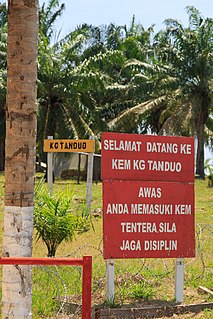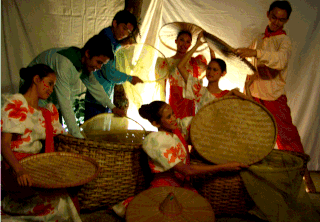
Mahārāja is a Sanskrit title for a "great ruler", "great king" or "high king". A few ruled mighty states informally called empires, including ruler Maharaja Ranjit Singh, founder of the Sikh Empire, and Maharaja Sri Gupta, founder of the ancient Indian Gupta Empire, but 'title inflation' soon led to most being rather mediocre or even petty in real power, while compound titles were among the attempts to distinguish some among their ranks.
The Malay language has a complex system of styles, titles and honorifics, which are used extensively in Brunei and Malaysia.
Datuk is a Malay title commonly used in Brunei and Malaysia, as well as a traditional title by Minangkabau people in Indonesia, and in East Timor. The title of the wife of Datuk is Datin.

The Sultanate of Sulu was a Muslim state that ruled the islands in the Sulu Archipelago, parts of Mindanao, certain portions of Palawan and north-eastern Borneo.

The Tausūg or Suluk are an ethnic group of the Philippines, Malaysia and Indonesia. The Tausūg are part of the wider political identity of Muslims of Mindanao, Sulu and Palawan. Most of the Tausugs have converted into the religion of Islam whose members are now more known as the Moro group, who constitute the third largest ethnic group of Mindanao, Sulu and Palawan. The Tausugs originally had an independent state known as the Sulu Sultanate, which once exercised sovereignty over the present day provinces of Basilan, Palawan, Sulu, Tawi-Tawi, Zamboanga City, the eastern part of the Malaysian state of Sabah and North Kalimantan in Indonesia.

Datu is a title which denotes the rulers of numerous indigenous peoples throughout the Philippine archipelago. The title is still used today, especially in Mindanao, Sulu and Palawan, but it was used much more extensively in early Philippine history, particularly in the regions of Central and Southern Luzon, the Visayas and Mindanao.

The Sultanate of Maguindanao was a Sultanate state that ruled parts of the island of Mindanao, in southern Philippines, especially in modern-day Maguindanao province and Davao City. Its known historical influence stretches from the peninsula of Zamboanga to the bay of Sarangani. During the era of European colonization, the Sultanate maintained friendly relations with British and Dutch traders.
Jamalul ibni Punjungan Kiram III was a former self-proclaimed Sultan of the Sulu Sultanate who claimed to be "the poorest sultan in the world". He was known as an unsuccessful candidate for senator in the past Philippine general elections in 2007. In 2013, Kiram III sparked a controversy when he revived a dispute between the Philippines and Malaysia by leading an intrusion into the eastern part of Sabah. His daughter is Princess Jacel Kiram, a proponent of the Sabah claim of the Philippines in 2016.
The Tagalog maginoo, the Kapampangan ginu, and the Visayan tumao were the nobility social class among various cultures of the pre-colonial Philippines. Among the Visayans, the tumao were further distinguished from the immediate royal families, the kadatoan.
Sultan Muwallil Wasit, is the 9th Sultan of Sulu and was also known as Rajah Bongsu I. His birth name was Pangiran Shahbandar Maharajalela, and was the youngest son of former Sultan of Brunei Muhammad Hassan. He reigned in Sulu after his uncle, Sultan Batara Shah Tengah died without an heir. He was most likely sent to Sulu to end dynastic troubles there, as he was begot of the marriage of Batara Tengah's Sister, and the Sultan of Brunei. On his coming to Sulu in 1609, this Pangiran Shahbandar Maharajalela @ Raja Bongsu-I ibni Sultan Muhammad Hassan brought along his royal symbol's called as "Pulau Janggi" and "Sepong Janggi". This royal symbol was a symbol of brotherhood between Sulu Sultanate and Brunei sultanate. And as a royal proof to Raja Bongsu-I as he was really belongs to Brunei Sultanate royal family. So, at present to identify the true Sulu Sultanate heir's is by identify who is the sulu royal family mandated to {Holding} this royal symbol. And the person who can proceed to have a photo's while holding this royal symbol, that person indeed is the true Sulu Sultanate heir AND also the true Successor to the Sulu Sultanate kingdom.

The Sultanates of Lanao in Mindanao, Philippines were founded in the 16th century through the influence of Shariff Kabungsuan, who was enthroned as first Sultan of Maguindanao in 1520. The Maranaos of Lanao were acquainted with the sultanate system when Islam was introduced to the area by Muslim missionaries and traders from the Middle East, Indian and Malay regions who propagated Islam to Sulu and Maguindanao.
Datuk is a traditional, honorary title bestowed on a person by the agreement of a people or tribe in the Minangkabau language, spoken by the Minangkabau people of Indonesia and Malaysia. The title of Datuk was agreed upon by local, traditional leaders. The title engenders great respect, and is only used for Minangkabau men who have become stakeholders of traditional leaders or penghulu (noblemen) for a particular tribe. When the title is bestowed, it is celebrated with a traditional ceremony and a banquet.

Muedzul Lail Tan Kiram is the head of the Royal House of Sulu, a position which he has held since 16 February 1986. As the eldest son of the former Sultan Mohammad Mahakuttah Abdulla Kiram, he is the legitimate heir claimant to the throne of the Sultanate of Sulu. He is a pretender to the throne as the 35th Sultan of Sulu.
The Royal House of Sulu is an Islamic royal house which ruled the Sulu Sultanate. In 1962, the Philippine Government under the leadership of President Diosdado Macapagal officially recognized the continued existence of the Royal Sultanate of Sulu.

The Royal and Hashemite Order of the Pearl is the dynastic order of the Royal House of Sulu, which serves as the premier institution and the highest personal honour of and in the Royal Sultanate of Sulu. The order is an honourable and nobiliary corporation instituted as a dynastic Order of Datuship analogous to traditional dynastic orders of chivalry, and is in direct continuation from the ancient customs and distinctions of the Royal Sultanate of Sulu and the Court of the Sultan. Ampun Sultan Muedzul Lail Tan Kiram, as Head of the Royal House of Sulu, is the hereditary sovereign who processes the fons honorum and Grand Sayyid of the order, and his heirs and successors as heads of the Royal House of Sulu, shall ever be sovereigns and Grand Sayyids of the order.
Ismael ibni Punjungan Kiram II was a self-proclaimed Sultan of the Sultanate of Sulu from 12 March 2001 until his death.

The 2013 Lahad Datu standoff was a military conflict that started on 11 February 2013 and fully ended on 24 March 2013. The conflict began when 235 militants, some of whom were armed, arrived by boats in Lahad Datu District, Sabah, Malaysia from Simunul island, Tawi-Tawi, in the southern Philippines. The group, calling themselves the "Royal Security Forces of the Sultanate of Sulu and North Borneo", was sent by Jamalul Kiram III, one of the claimants to the throne of the Sultanate of Sulu.

In the Philippine languages, the Filipino honorific styles and titles are a complex system of titles and honorifics, which are used extensively during pre-colonial era, mostly the Tagalogs and Visayans borrowed the Malay language systems of honorifics specially the Moro peoples of Mindanao based on the Indianised Sanskritised Indian honorifics system, in addition to the Chinese systems of honorifics in like the Ma-i (Mindoro) and the Pangasinan. Indian influence is evidenced by the titles of historical figures such as Rajah Sulayman, Lakandula and Dayang Kalangitan. Malay titles are still used by the royal houses of Sulu, Maguindanao, Maranao and Iranun on the southern Philippine island of Mindanao, but these are retained on a traditional basis as the 1987 Constitution explicitly reaffirms the abolition of royal and noble titles in the republic.

The Lahad Datu District is an administrative district in the Malaysian state of Sabah, part of the Tawau Division which includes the districts of Kunak, Lahad Datu, Semporna and Tawau. The capital of the district is in Lahad Datu Town.











